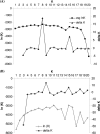Expansion of genetic diversity in randomly mating founder populations of Alternaria brassicicola infecting Cakile maritima in Australia
- PMID: 20097819
- PMCID: PMC2837991
- DOI: 10.1128/AEM.01594-09
Expansion of genetic diversity in randomly mating founder populations of Alternaria brassicicola infecting Cakile maritima in Australia
Abstract
Founder populations of fungal plant pathogens are expected to have low levels of genetic diversity coupled with further genetic drift due to, e.g., limited host availability, which should result in additional population bottlenecks. This study used microsatellite markers in the interaction between Cakile maritima and the fungal pathogen Alternaria brassicicola to explore genetic expectations associated with such situations. The host, C. maritima, was introduced into Australia approximately 100 years ago, but it is unknown whether the pathogen was already present in Australia, as it has a wide occurrence, or whether it was introduced to Australia on brassicaceous hosts. Eleven A. brassicicola populations were studied, and all showed moderate levels of gene and genotypic diversity. Chi-square tests of the frequencies of mating type alleles, a large number of genotypes, and linkage equilibrium among microsatellite loci all suggest A. brassicicola reproduces sexually. Significant genetic differentiation was found among populations, but there was no evidence for isolation by distance effects. Bayesian analyses identified eight clusters where the inferred clusters did not represent geographical populations but instead consisted of individuals admixed from all populations. Further analysis indicated that fungal populations were more likely to have experienced a recent population expansion than a population bottleneck. It is suggested that A. brassicicola has been introduced into Australia multiple times, potentially increasing the diversity and size of any A. brassicola populations already present there. Combined with its ability to reproduce sexually, such processes appear to have increased the evolutionary potential of the pathogen through recent population expansions.
Figures



References
-
- Agapow, P. M., and A. Burt. 2001. Indices of multilocus linkage disequilibrium. Mol. Ecol. Notes 1:101-102.
-
- Anagnostakis, S. L. 1987. Chestnut blight: the classical problem of an introduced pathogen. Mycologia 79:23-37.
-
- Anderson, P. K., A. A. Cunningham, N. G. Patel, F. J. Morales, P. R. Epstein, and P. Daszak. 2004. Emerging infectious diseases of plants: pathogen pollution, climate change and agrotechnology drivers. Trends Ecol. Evol. 19:535-544. - PubMed
-
- Avenot, H., A. Dongo, N. Bataille-Simoneau, B. Iacomi-Vasilescu, B. Hamon, D. Peltier, and P. Simoneau. 2005. Isolation of 12 polymorphic microsatellite loci in the phytopathogenic fungus Alternaria brassicicola. Mol. Ecol. Notes 5:948-950.
-
- Banke, S., and B. A. McDonald. 2005. Migration patterns among global populations of the pathogenic fungus Mycosphaerella graminicola. Mol. Ecol. 14:1881-1896. - PubMed
MeSH terms
Substances
LinkOut - more resources
Full Text Sources

